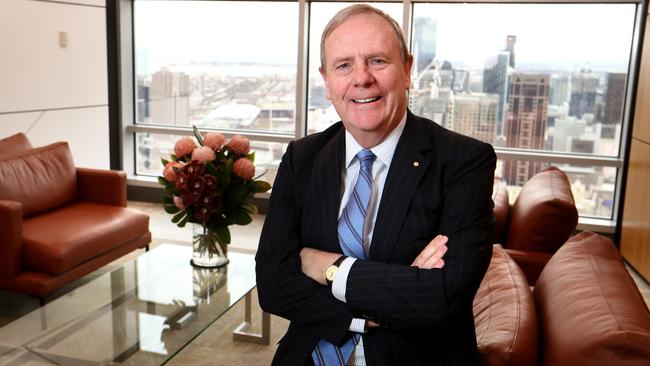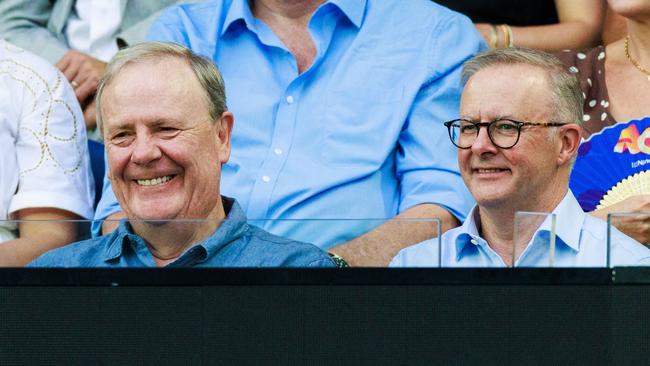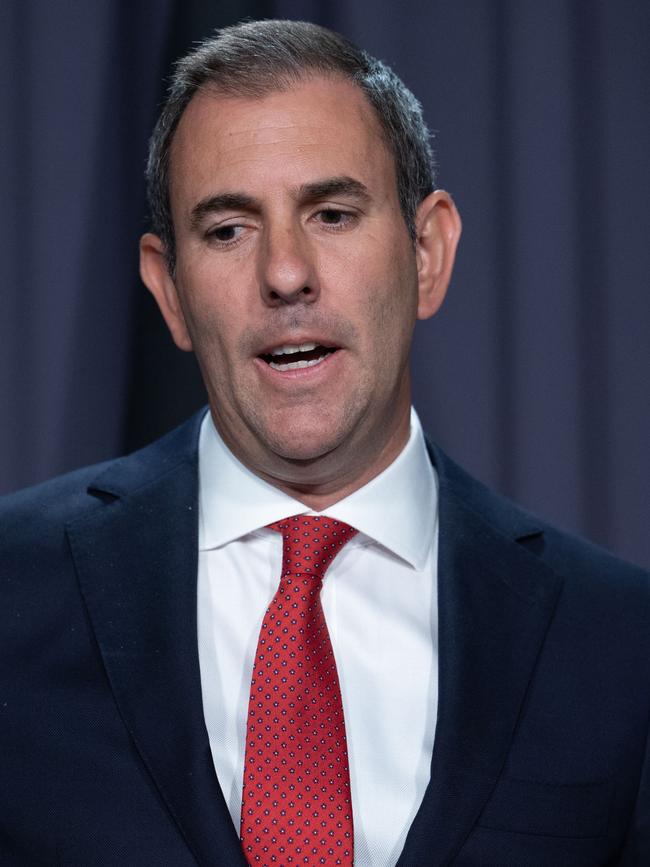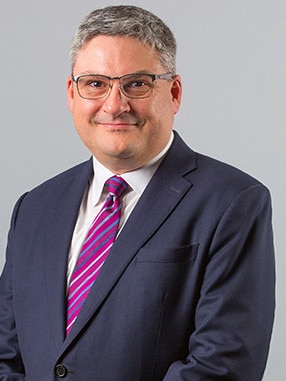
The Future Fund chairman believes business should be in the business of business and governments should stick to their own lane. Nor should Canberra be tempted to start instructing the $196bn Future Fund where or how to invest.
The comments were in response the 6000-word essay released this week by Jim Chalmers, who called for a new form of values-based capitalism, urging companies and super funds to step up efforts on impact investing and spending with social purpose. In the essay, the Treasurer also noted “co-investment is a powerful tool” at the government’s disposal.
Costello was treasurer in 2006 when the Future Fund was established. At the time the idea was to build an independent savings pool to help address spending pressures brought on by the ageing of the population: in particular the ballooning unfunded commonwealth superannuation liabilities.

Costello has been the biggest defender of the Future Fund’s “fierce independence” from government and has said this independence has long been respected by both sides of politics over the 16-year life of the fund.
The message was repeated on Wednesday, with Costello saying the Future Fund operated at arm’s length from Canberra.
“Under various governments Coalition and Labor, there’s never been any attempt to direct the funders to what investments it should take. And I think once you start down that path, it would come to a very bad end,” Costello said during a market briefing.
“If people start thinking they can take this money and direct it to various purposes of their own, I think the game would be up, there wouldn’t be any point in continuing to have an investment.”

Costello pointed out the government has the Clean Energy Finance Corporation which has a clear mandate to invest and take risks on renewables. The Future Fund has a different mandate.
“The Future Fund is an institution, which is designed to invest for the big fiscal risks that are coming down the pipeline. Be it in terms of government debt, in terms of unfunded liabilities, in terms of ageing of the population, the Future Fund is the government’s biggest financial asset. It’s an asset that … more than anything else contributes to maintaining our credit rating”.
Costello, who is also chairman of media group Nine Entertainment, was echoing the thinking around boards in recent days.
Businesses can’t be a catch-all for everything.
The nation’s biggest companies from miners to property trusts all have a clear environment, social and governance framework.
However, Costello points out a business ultimately answers to boards who answer to shareholders. “This idea that every institution must be given every purpose, I think you’ll just lose focus,” he says
As treasurer for more than a decade as part of the Howard government, Costello is one of the architects of modern Australian neo-liberalism that Chalmers was calling out.
Fund loss
Meanwhile, the $196bn Future Fund is clearly holding on to its bearish outlook for the coming year, even in the face of the optimism that is starting to flow into global markets. And this outlook is backing its conviction to become one of the biggest investors in hedge funds, giving it some protection in falling markets.
With hopes the US might be able to avoid a hard landing and signs that inflation may have peaked, this is giving investors hope that central banks may be reassessing their outlook for aggressive interest rate hikes. This is the driver of the 6 per cent jump in the MSCI World shares index this year and the 8 per cent jump in Australia’s S&P/ASX 200 index.

But the fund, which only has 24 per cent of its holdings tied up in shares, still sees the risk of a major recession.
The comments by chief executive Raphael Arndt come as the Future Fund delivered a negative 3.7 per cent return for the calendar year 2022. This ranks as one of its worst performances since the global financial crisis, and comes on a year when Wall Street suffered double-digit percentage losses.
Returns over three years are 5.3 per cent, but still a robust 9.1 per cent annualised over 10 years.
Arndt says it was clearly a year of two halves with surging interest rates causing equity markets to crater in the year, but the fund had a positive December half, growing 0.9 per cent. Despite the strong start to the current year, the coming period is set to deliver volatility
“We think markets have adjusted quite a bit now. But they’re still not pricing a major recession. And that is the risk looking forward from here,” Arndt says. The fund is currently sitting with a slight defensive tilt in anticipation of further negative shocks.

By way of comparison earlier on Wednesday the giant Norges Bank Investment Fund – the world’s biggest sovereign wealth fund – delivered a return of negative 14.1 per cent for last calendar year. The Norway-backed fund, with the equivalent of $1.76 trillion under management, says the “uncertainty” into the coming year remains higher than normal even after a strong rally in global markets into January. The scale of the fund means the falls translate to a loss of $248bn – the equivalent to all the assets being managed by local fund giant Australian Super.
For the Future Fund much of the risk it sees is around the lag effect of rising interest rates as they are felt through the economy.
This means “any type of investment where the underlying business is exposed to the consumer or leveraged businesses is something we’re watching quite carefully”, Arndt says.
This week’s numbers showing a massive fall in December retail sales is a pointer of things to come, although key retailers from JB Hi-Fi to Myer have reported a positive Christmas period.
Last December, Arndt released a major position paper which sought to turn the traditional idea of a 60-40 portfolio upside down. For decades, the rule of thumb had been 60 per cent shares and 40 per cent fixed interest to steer through any economy cycle. But Arndt and his fund colleagues believe inflation is set to be entrenched, which means interest rates are likely to be higher for longer. This means there needs to be a different approach.
He says these forces are starting to play out. Inflation remains sticky and will be hard to get back to the target range of most central banks, and geopolitical tensions remain embedded in the system.
In response, the Future Fund has been increasing its exposure to alternative assets, which is mostly built around hedge funds. It is also long on infrastructure, property and has become a direct investor in commodities such as gold.
Indeed, exposure to alternatives was the biggest mover over the past year which now represents 17 per cent of the fund from 14 per cent a year ago. At more than $33bn in alternatives, the Future Fund has hit the ranks of a “super shorter”. The most common hedge fund strategy is shorting a stock – that is, betting a company’s share price will fall.
Interestingly, the Future Fund’s Australian shares exposure has increased slightly to 8.6 per cent from 7.6 per cent, largely at the expense of emerging market shares which it believes remain too risky.
Arndt says the strategies it uses across hedge funds can make money in falling markets: “We’re looking for strategies that can perform in falling markets or rising interest rate environments, and the hedge funds play a really important part in that strategy.”
Half-year results
Like Christmas time for retailers, some 60 per cent of outperformance for fund managers comes through the results season. From next week corporate Australia really moves into its reporting for the December half-year results.
As always shares will rise or fall on the outlook as well as beats or misses on the headline result. There is also the prospect of a capital return although chances in the current climate are diminishing, with companies likely to prefer to pay down debt.

It’s getting tougher for ASX-listed companies with inflation starting to become baked in, while consumer-facing companies are anticipating a drop-off in demand.
For companies likely to deliver a positive surprise, Goldman Sachs’ equity team nominates QBE, Qantas, retailer Temple and Webster, Judo Capital, Telstra and Breville. Companies primed to deliver negative shocks include Sonic Healthcare, Coles, Bega Cheese and Tabcorp.




After sitting next to Anthony Albanese for more than two hours at the Australian Open on Saturday night, Peter Costello chose his words carefully but the message was clear.